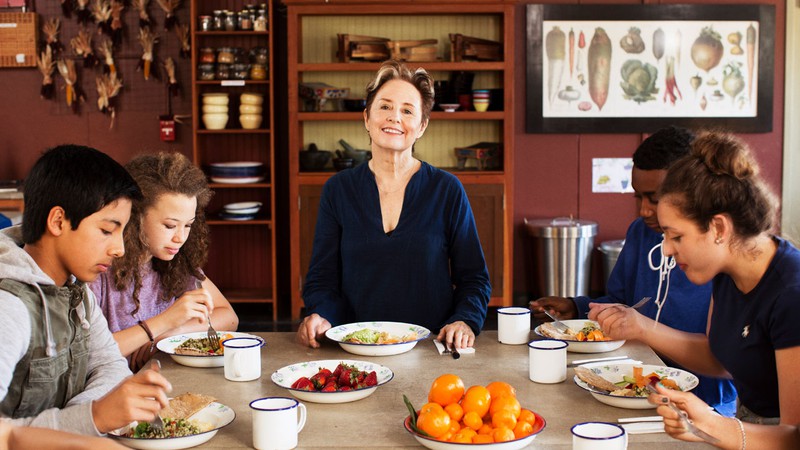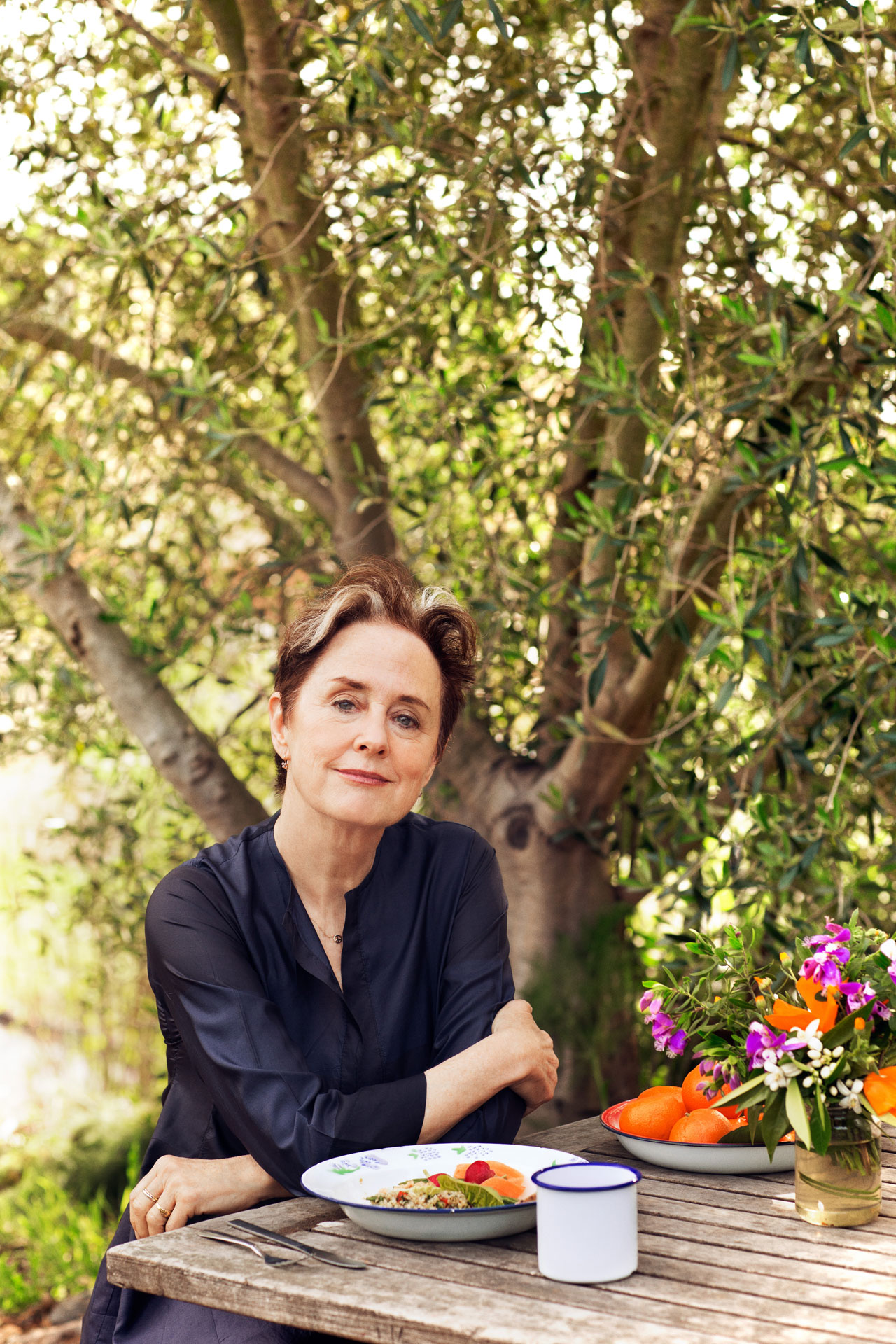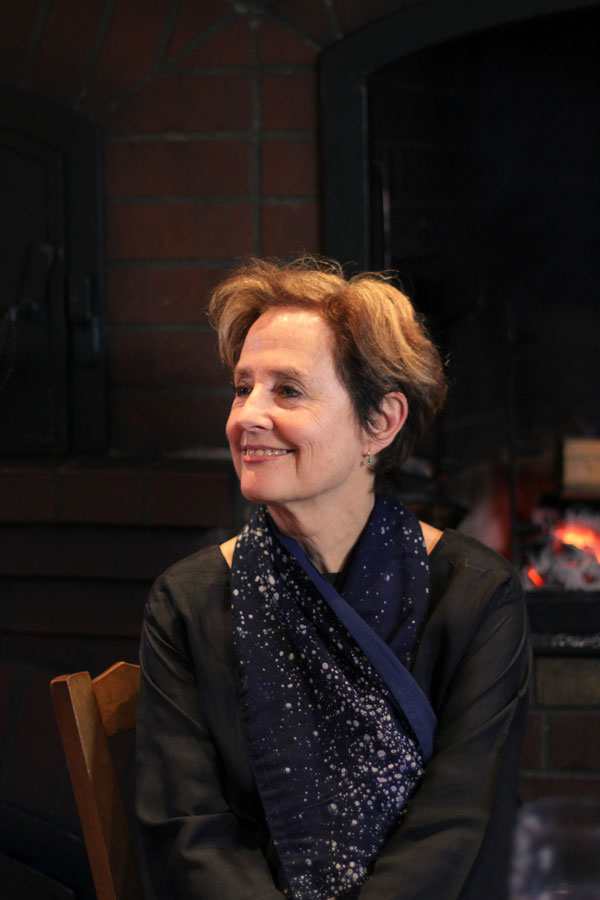The renowned Berkeley chef talks about the future of the Alice Waters Institute for Edible Education.

For many years, chef Alice Waters has taught young people about the importance of sustainable eating. Now she’s building a new place of learning in Sacramento. Photo by Amanda Marsalis
When Aggie Square—a $1.2 billion research and innovation center currently under construction in Sacramento—is eventually up and running, one of the anchor tenants will be a familiar name to culinary aficionados: Alice Waters, the longtime owner of Chez Panisse.
The soon-to-be 78-year-old Waters, who is lending her name to and will be involved in the Alice Waters Institute for Edible Education at Aggie Square, sat down via Zoom with California Local to discuss the impetus for her work.
The following conversation has been edited for length and clarity.
California Local: You’re a really celebrated person in the food world, and it seems like at this point in your life, you could do a lot of different things. So what is it that drew you to Aggie Square?
Alice Waters: Well, the fact that I just want to change the world. I figured that the two things that we have in common everywhere are education and food. And I’ve been 52 years at Chez, and what has made it what it is is the local seasonal, organic, regenerative food that we serve. I’m absolutely convinced about that. It’s about taste. And the only way that you will have taste is if you pick it in your backyard when it’s ripe. You can’t have taste if you don’t.
I mean, the food that is shipped around the world is very questionable—not only the sourcing of it, but the taste of it. You can’t ship fried food. And we never did this in this country before 1950. We only had coffee, tea, and spices and maybe I had an orange at Christmas, when I lived in New Jersey. My father had a few dates sent in from California. But that was it. You ate the food that was grown locally. It’s probably why I’m so in love with New Jersey tomatoes.
But that idea just is confirmed completely by the restaurant. The fact that that we buy directly from the farmers, we don’t have any middleman, no Sysco. That gives the farmers the money they need to take care of the workers and the whole thing, take care of the land. And so I thought after the 26 years of the Edible Schoolyard Project, I don’t know what you know about that…
Please feel free to elaborate.

The Edible Schoolyard was something that happened because a school principal called me on the phone about 27 years ago and he said, “I know you like gardens, and I thought maybe you’d come to my school, Martin Luther King Middle School in Berkeley, and beautify it.” And I was astonished to hear from him.
I am a Montessori-trained teacher. I’ve always known that learning by doing is the best way to learn. I’ve always known that it’s the education of the senses that are the pathways into our minds. And so we need to be smelling and tasting and all of this.
I of course went over to talk to [Principal] Neil Smith. I said, “What did you have in mind?” And he said, “Whatever you want to do.” That is my favorite answer. And I just said, “I’ve looked at that campus, which was built in 1921 on 17 acres of land for 500 students and now there are 1,000 students and half the land is taken by the city for other purposes.” They have only a snack bar at the end of the playground where kids got their lunch. And I just said, “Okay, Neil, are you ready? I’m going to apply all my Montessori.” I said I’d see a garden and a kitchen classroom, not to teach gardening or cooking per se, but to teach all the academic subjects.
So we did everything. He said, “You hire whoever you want.” And I said, “I have to hire somebody who loves cooking and respects children. They may not be accredited teachers, but they’re great.” He said, “Hire them. I’ll take the consequences.” Well, we hired Esther Cook, just happened to be named Cook, but she was an artist and she loved children. And she created this beautiful classroom.
The students, and there were 1,000, who spoke 22 different languages at home. … When they were doing geography of the Middle East, they’d be cooking pita bread and hummus. And I just watched that transform the whole experience of being in school. They loved this class. The same thing happened to the garden. And it could be a music class out there. It could be biology, a science class. And they loved to be outside, of course. All children want to be out in nature.
Now—I have to show you something.We just did this one experiment in one school, just the way I did only one restaurant. And I tried to allow the word to go out. We did academies to teach other people, and we started a few edible schoolyards around the country to have proof of concept: in a big city in LA, one in New Orleans, one in North Carolina, one in the Bronx and one in upstate New York. So we got the snow, we got the heat, and we wanted to know whether it would work and it worked like a charm. And I’m just holding this up (holding a map) so you can see the 6,200 schools of the world.
So your program has expanded that far.
It did because it’s about human values. People heard about it, said what a good idea and did it, and connected with us. I have no idea what's going on at these schools except that they’ve embraced the ideas of organic, of community, of diversity, of just edible education as being extremely valuable.
It is those two things: The restaurant buying directly and really connecting to the farmers. Once we put out the word that we were paying the real costs, everybody wanted to sell to us…That made me understand that schools can support farmers who take care of the land, pull down the carbon around climate, and of course, it’s the only way to have nutrition…
I wrote a book called We Are What We Eat, and the thesis of that book is that that we have been eating fast food for 50-60 years; and we’ve been eating the values that come along with the food, that time is money, that more is better, that food should be fast, cheap and easy, that it should be available 24/7. I want what I want, I don’t want to eat, it’s okay to eat in the car, uniformity.
All of those ideas have just spread around this country. I do believe that’s because we’ve lost our democracy and we’ve really become, I think, imprisoned by these beliefs. So I thought that the best way to address this would be for schools, public schools, to support the farmers, and in this way.So then I said, “Well, maybe we should do it with the UC system.”
That makes sense.
It did to me. Having been in Berkeley in the ’60s, I knew what it was about. I just said, “If we do a model here with UC it will go across the country, it will go around the world.” I talked with [then-UC President] Janet Napolitano before she left office. She thought that it could be part of the carbon neutrality for 2025. Maybe it’s too soon, but it certainly could fit with all of the climate initiatives.
She brought President [Michael] Drake [of the UC system] to my backyard, and I’ve been talking with him. Then the president at Davis asked if I wanted to do an institute for education at Aggie Square. And I said, “How wonderful.”

How involved you intend to be with the center? Will you be involved in the day-to-day instruction at all? Would it be more of a role of sitting on a board? Or is this something where you’ve got the idea and you’ll have other people who flesh it out?
Oh, I have to have that. But I see it as a place. The one missing piece, I think, in terms of doing this, is how do you cook affordable, seasonal, local food, buying it directly from the farmers, the ranchers, the fishers. So I thought this could be an incredible kitchen for teaching, and I decided I wanted something beautiful. I remembered the Brighton Pavilion in England and the kitchen there was so beautiful.
I want to teach in a regenerative way. In other words, I want everybody to feel like they have a part in the kitchen to play. I want a big table where we all talk like we do at Chez Panisse and where there’s an open kitchen and where we could see 100 people sitting down. So every time we cook, we can invite people from Sacramento, the teachers, to be part of that. Food service directors. We can have lectures at night. We can show films. I want it to feel like it’s almost like a community center.
Its main purpose will be to demonstrate the ease with which you can connect with the farmers. Their values come right through the kitchen door or the cafeteria door of the school. I know that we know a lot about affordable food around the world, from The Edible Schoolyard project, what kids really like to eat. That will be its main purpose is teaching this kind of cooking.
Its secondary purpose will be reallyand maybe not secondary—is bringing the powers that be in Sacramento into conversations with people from around the world, whether it’s a Carlo Petrini, Michael Pollan, or Eric Schlosser or also people that are in the education place, because I feel like Montessori education is where we need to go. We have lost our connection both to nature and our connection with ourselves.
I hear you on that. I was doing some prep for this interview and one thing that we have in common is you’re a believer in slow food and I’m a believer in slow news. I like to do things thoughtfully. I try to be as nuanced as I can. And our world has just become so much about speed.
That’s true. And it’s really done damage. My book, I did it with two other friends. We spent two years struggling to write it, because we wanted to be able to describe in a visceral way, in words, what beauty is about when people haven’t experienced that. We’ve lost our connection to nature. And we’re afraid. We have to go buy all the clothes and the tents and everything before we dare go out there. And something is deeply wrong when we are afraid of nature.
Do you intend to be in the kitchen at Aggie Square?
Somebody who has run the kitchen at Chez Panisse will of course be there in an everyday way. I am absolutely going to be there depending on how I’m needed. But there are people that are much better cooking teachers than I am. … I know chefs from around the world and I hope they will come and really bring their knowledge of affordable, wholesome food to the institute.
I love being in Sacramento because it is the capital of the state. I think it’s important that colleges connect with the real world of a city like Sacramento, where there’s no separation of town and gown. I’ve always had that as a problem at Berkeley, because it really is separated.
And I appreciate the enthusiasm, both from Chancellor May and from the mayor in Sacramento, and of course, Gavin and Jen [Newsom, the governor ,and Siebel Newsom, First Partner of California.]
Are you hoping that Aggie Square will be part of your legacy?
This idea, absolutely—that school-supported agriculture, where the schools become the economic engine to support the people who take care of the land for our future. I can’t think of anything more important right at this moment. And it’s not just what we’re eating, it’s how we’re eating. I’ve been working at the American Academy in Rome for the last 15 years. That was a place where they wanted interdisciplinary conversations to happen. Yet, they didn’t have any good food at the table. So nobody wanted to go and eat.
It took an enlightened director to call me on the phone to say come change the [process] which I did, and everybody came back to the table. And I stayed there for two hours and had these wonderful discussions.
So I know that food—real food—has magic. Has power. And it can be the place—the dinner table can be a joyful place.
It’s such a pleasure to talk with you. And I always try to ask people, is there anything I didn’t ask you or anything that’d be good for people to know?
Well again, the hardest thing for me to communicate is—because the fast food indoctrination is so deep—is that food can be affordable, if it’s local and seasonal. People think I’m a high-end restaurant and I don’t know anything about this. But I have been in schools for a long, long time. I know that we can do this for the same amount of money as we get for reimbursement from the USDA for the public school system. I’m writing a book that is going to demonstrate that, but people just don’t believe it. And it’s something that I hope the Institute can really communicate.
Well, thank you so much for being available for this. Anything else you want to say?
I don’t think so. Except we can’t underestimate beauty. … We have to know that beauty is important in our hearts, that every choice we make should be considering that.